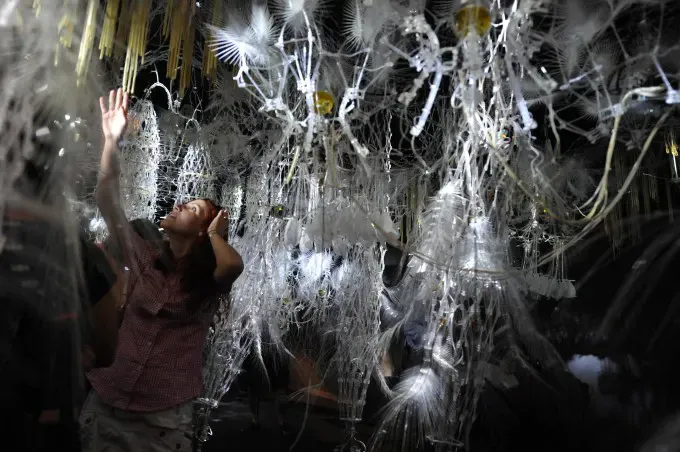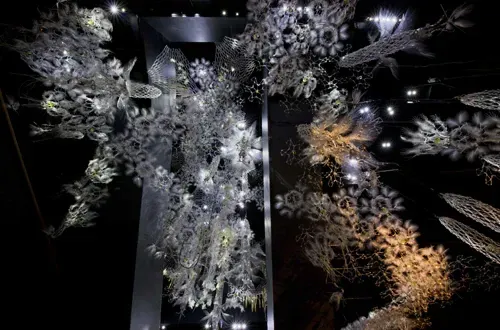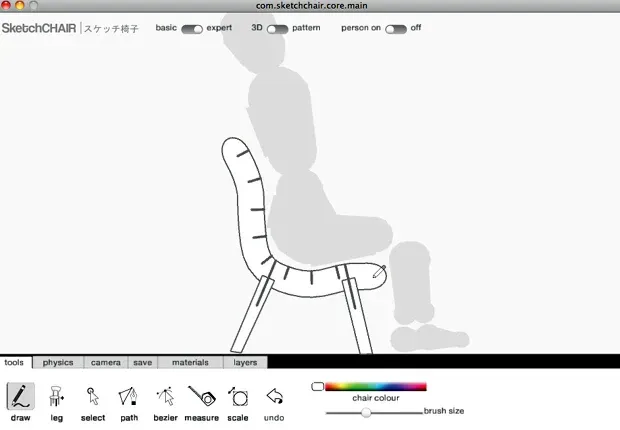Schooled in Design
Written by

Designers and design researchers are gathering at Victoria University in Wellington next week (April 18-20) for DeSForM. School of Design deputy head Margaret Maile Petty tells us more about the international conference, professional day and exhibition Fabricating Futures.
"DeSForM is built around the notion of sound, yet meaningful design research, and that continues to be a constant. But I think what we are adding to the mix is a focus on new digital tools and methods at work in design today as well as calling attention to the emergence of what we call the digital creative sector."
What is DeSForM?
DeSForM or Design Semantics, Form and Movement is an international biennial forum for design that is being hosted this year by the School of Design at Victoria University. In addition to the academic conference we are running a special one day Professional Programme on April 20th for creative practitioners, industry professionals, students, and all those involved in design and innovation.
DesForM began in 2006 as an annual gathering of like-minded designers and design researchers interested in sharing ideas around the human context and expression of design. Today the international committee is composed of leading figures from across both practice and academia including Professor Steven Kyffin from Northumbria University of Design, UK, (formerly Director of Design Research and Innovation at Philips), Professor Loe Feijs from the Technical University Eindhoven, NL, and Professor Lin-Lin Chen from the National Taiwan University of Science and Technology, Taiwan.
How did Vic Uni's School of Design School come to host it?
Some people have said that Victoria University’s best kept secret is the School of Design. So we wanted to find a way of highlighting the innovative research culture at the School of Design by holding an international forum in our midst.
Maxe Fisher, the founding director of our Context+Culture programme first attended the DeSForM2009 conference in Taipei, Taiwan and suggested that this community of scholars and designers were in close alignment with the School of Design’s vision. Simon Fraser, Head of Victoria’s School of Design then traveled to Lucerne, Switzerland to participate in DeSForM2010, and asked the conference organizers for the opportunity to host the 2012 conference.
What fresh perspective does NZ bring to DeSForM?
DeSForM is built around the notion of sound, yet meaningful design research, and that continues to be a constant. But I think what we are adding to the mix is a focus on new digital tools and methods at work in design today as well as calling attention to the emergence of what we call the digital creative sector. While I suppose you could argue that previous DeSForM conferences have privileged physical interactions, we are bringing much more attention to the digital experience and the ways in which this is changing physical and human interactions. Also we have worked hard to bring a deeper connection with industry to expand the dialogue between research and practice.
The theme is Meaning Matter Making – what does this mean and why does it matter?
Knowing we wanted to create a forum for exploration of the ‘digital’ and how it factors into design today, we felt we needed to express this in the title of our conference, yet leaving room for multiple interpretations. The concept embodies the ‘meaning’ of design, physicality, and interaction; it questions understandings of ‘matter’ as tangible, organic, and meaningful; and highlights ‘making’ as a distinctly human activity that can take many expressions and forms. We thought these three words nicely summed up the bigger objectives we held for the conference.
What new directions and areas of design are being explored in the academic presentations?
While each of the academic presentations to some extent introduces new approaches within design, the topics which sit closest to the outer boundaries of design today include immersive environments, smart systems, augmented reality, and interactive spaces, as well as the rapidly developing field of digital fabrication and manufacture.
What are some of your personal highlights/speakers?
Of course I might be biased, but one of my favourite speakers is Tiago Rorke of Diatom. For full disclosure, Tiago graduated from the School of Design the same year as I began with the University. I knew him just well enough to know he was a very talented and particularly sharp individual.
After graduating, he and Greg Saul, a fellow School of Design alumnus and friend, decided to develop their ideas around open-source digital design and fabrication. So they developed (among other things) the SketchChair project using the crowd-source funding platform, Kickstarter. Their open-source software programme enables any user (regardless of skill or experience) to design and build a chair. Within a month of its launch on Kickstarter they had raised the initial investment goal of $18,000 USD.
Tiago will be talking about this project, as well as his recent involvement in the Hackerspace, AltLab in Lisbon, Spain. To me this is terribly exciting. It is where the future of design is happening today. I’m also looking forward to Daniel Davis, Jane Burry, and Mark Burry’s presentation about a new real-time programming environment they have been developing called Yeti.
The trio come to the conference from Melbourne’s Spatial Information Architecture Lab (SIAL) at RMIT. SIAL is well-recognised as a leader in generative design and digital fabrication. We also have some great papers on interaction design, such as new research on gesture control by Tom Djajadiningrat and his team from Philips Design in the Netherlands.
What’s the idea behind the professional presentation day?
As a part of Victoria University, naturally academic research is the core of any initiative, but we wanted to ensure that the new knowledge and tools emerging from our academic staff were being shared with the professional community; and likewise that those of us within design education and research were connecting with the new directions emerging from industry.
In setting one day of the two-and-a-half day conference aside for dialogue and debate with industry leaders we feel confident we can bring these two spheres of the design community into direct, and hopefully, sustained contact.
The professional programme will feature presentations from design and industry leaders on Interaction Design, Transmedia, Technology and Entertainment, Immersive Environments, Digital Design, Fabrication, and Manufacture, and live demonstrations of technologies such as 3D printing, marker-less motion capture and augmented reality
What are some of the highlights?
That’s difficult for me because I truly do think that all our professional programme participants bring something special and innovative to the table. With presenters such as Weta Digital, Unlimited Realities, Sidhe (with PikPok), ClickSuite, RESN, 77Pieces, The Gibson Group, Mohawk Media, Ponoko and others I think we can confidently say that we have gathered a robust cross section of New Zealand’s digital creative sector. Luckily the sessions run consecutively, so I (and our participants) will be able to see all the presentations.
The exhibition extends for another three weeks. Tell us a bit about this and why it’s an important part of DeSForM?
The exhibition at the School of Design, Fabricating Futures curated by Bettina Neu, our Programme Director of Industrial Design, ultimately is the public face of the DeSForM conference. Offering an overview of innovative and experimental work from across New Zealand’s design community, the exhibition will highlight work from industry and professionals, School of Design academic staff and students, and independent makers. It provides a real opportunity for raising awareness about the future of design and to bring public attention to the importance of these new pathways for the continued success and viability of New Zealand design.
This exhibition celebrates the world-class talent and ingenuity that surrounds us in Wellington. That’s what we hope will be clear from the exhibition. We invite everyone to come by and see the exhibition. It is open to the public and is free of charge. In particular we are hoping to get local school groups in to see the show—the real future of New Zealand’s creative industries!
What roles do the School of Design students play in DeSForM?
At the School of Design we honour our students and recognize that often the best ideas come from them. So we were keen from the beginning to have our students as involved as possible in the both the design of the DeSForM 2012 ‘brand’ and the exhibition.
Jonathon Toon, a recent Media Design graduate designed the web page for the conference, Jamie Wau designed the custom display system for the exhibition with Senior Lecturer Tim Miller, and many of our students have been involved with other aspects of the exhibition design.
We also have a group of students participating in the installation of Philip Beesley’s Vesica at the City Gallery. Since the initial planning stages, it has been very much a collaborative process between our students and staff.
Tell us a little bit about your background?
I grew up on the West Coast of the United States, and studied Art History at the University of Oregon in Eugene. A city much like Wellington in terms of creativity and a thriving alternative culture. Then I moved to New York City to pursue my postgraduate studies in at the Bard Graduate Center—a remarkable place to study. Since completing my doctoral studies I have consistently worked within design schools. Before I moved to New Zealand I taught at Pratt Institute and Parsons the New School for Design both in New York City.
While my training is as a design historian, I have always been inspired by the vitality of the design community and have worked to integrate my critical skills as a historian into the analysis of contemporary design. I’ve also maintained a close connection with the professional community through my work as a design journalist. I feel fortunate that in my career I have been able to move quite fluidly between the academic and professional communities.
What attracted you to NZ?
As an American you grow up hearing stories about New Zealand as an unbelievable beautiful country of endless beaches, pristine glaciers, and happy sheep. So when I saw a job posting at Victoria University’s School of Design, I applied immediately. My partner and I had been living and working in New York City for almost a decade and while we enjoyed the vibrancy of the big city we wanted more connection with nature and a less hectic lifestyle.
Once I arrived in Wellington for my interview at the School of Design, I knew I had made the right choice. Not only did the city seem to be sparking with creativity and optimism (at this time New York City was in the initial throes of the financial crisis), but I was also drawn in by the innovative vision of the School of Design.
Having spent a number of years teaching at Parsons, where it seems so much is taken for granted, it was refreshing to see a young school with such passion for design and absolute fearlessness. The new Culture+Context programme, to which I was applying, also seemed to me to be the perfect embodiment of the future of design. As an interdisciplinary design programme built around the idea of integrated non-design minors matched well with my own interdisciplinary approach to design. So it was an easy decision to come to New Zealand.
Why is it important to make design visible outside of the design community?
As I hinted earlier, I strongly believe that the nature of design is rapidly transforming with the increasing dissemination and use of digital design tools, open-source software, 3D printers, and other additive manufacturing approaches. This new profile for design presents New Zealand with the opportunity to define itself as an international leader.
New Zealand can’t compete with the massive manufacturing capability of such industrial powerhouses as China, but it can easily become a world leader in terms of creative innovation and expertise. Companies like Weta Digital and Ponoko have already illustrated how this can work. But in order for New Zealand to clearly establish and maintain a global leadership position, I think there needs to be greater recognition and support for these emerging industries from both the government and the public sector. Greater visibility for design, outside of the design community, therefore is necessary to ensure popular support and continued growth for New Zealand’s design industry.
What’s your Big Idea for 2012?
To join a Hackerspace and get in touch with my inner maker.
* * * The Big Idea Birthday Questions * * *
What does The Big Idea mean to you?
The start of the day. It is my easy one-stop site for all that’s new, noteworthy and happening in New Zealand’s creative community. It’s been an invaluable ambassador for this American transplant.
What changes have you noticed in Design in the past 10 years?
It would be easier in many ways to say what has stayed the same – that is the creative, experimental energy of the design community – than what has changed, which is almost everything. The last decade has seen an explosion in open-source software, generative and procedural design methods, ubiquitous computing, RFID tagging, 3D modeling and fabrication, and on and on. But we can find continuity in the innovative, challenge-seeking nature of the design community. That’s what I love about design. You never get bored.
What are some of the opportunities and challenges for the next decade?
The biggest challenges for all of us, I think, are finding new, more sustainable and ethically responsible methods and practices. Not just within the design community but across society. But it is particularly important for design, as it is design that interfaces most closely with the public at the site of consumption and consumer practices.
We all have to rethink how and where we get our daily necessities and our cherished indulgences. It’s not that we can’t have these things, but we need to be smarter about it. This is a challenge perfectly suited to design. We just need to make it a priority.
***
- The 7th annual Design Semantics Form and Movement (DeSForM) conference from April 18 - 20th 2012.
Margaret Maile Petty is a senior lecturer in the Culture+Context program at the School of Design, Victoria University of Wellington, New Zealand.


